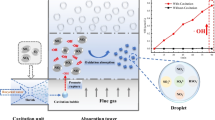Abstract
NOx, a generic term for the nitrogen oxides generated from combustion in the presence of nitrogen, is a serious threat to human health. This study examined the removal of NOx using ammonia (NH3) and ozone produced using a silent discharge method. The effects of temperature and residence time on NOx removal with NH3 injection in a double reactor system were investigated. An increase in temperature resulted in higher levels of O3 decomposition, whereas the maximum particle formation in the form of ammonium nitrate (NH4NO3) was achieved when both reactors were kept at 180 oC. NH3 and O3 injection in large quantities and NO in smaller amounts with a residence time of 10.2 s resulted in the maximum particulate formation. In contrast, when an excess of NH3 was supplied, it resulted in N2O formation due to the formation of NH2 radicals generated from a reaction of NO2 with NH3. In addition, 100% NO removal was achieved regardless of the residence time. Kinetic simulations indicated the possibility of moisture being the limiting reactant.
Similar content being viewed by others
References
Y. Xiong, Y. Zeng, W. Cai, S. Zhang, J. Ding and Q. Zhong, J. Ind. Eng. Chem., 65, 380 (2018)
X. Long, B. Duan, H. Cao, M. Jia and L. Wu, J. Ind. Eng. Chem., 62, 217 (2018)
H. Wang, X. Li, P. Chen, M. Chen and X. Zheng, Chem. Commun., 49, 9353 (2013)
S. Roy and A. Baiker, Chem. Rev., 109, 4054 (2009)
Y. Fan, W. Ling, B. Huang, L. Dong, C. Yu and H. Xi, J. Ind. Eng. Chem., 56, 108 (2017)
M. Shelef and R. W. McCabe, Catal. Today, 62, 35 (2000)
F. Garin, Appl. Catal. A: Gen., 222, 183 (2001)
S. Tsukamoto and T. Namihira, Pulsed Power Conference, Monterey, CA, 1330 (1999)
J. O. Chae, J. Electrostatics, 57, 251 (2003)
J. O. Jo and Y. S. Mok, Appl. Chem. Eng., 29, 92 (2018)
H. Fujishima, K. Takekoshi, T. Kuroki, A. Tanaka, K. Otsuka and M. Okubo, Appl. Energ y, 111, 394 (2013)
T. Kuroki, M. Takahashi, M. Okubo and T. Yamamoto, IEEE Trans. Ind. Appl., 38, 1204 (2002)
S. Tsukamoto, T. Namihira, D. Wang, S. Katsuki, H. Akiyama and E. Nakashima, Digest of Technical Papers 12th IEEE International Pulsed Power Conference (Cat No99CH36358), 2, 1330 (1999)
H. Lin, X. Gao, Z. Y. Luo, S. P. Guan, K. F. Cen and Z. Huang, J. Environ. Sci. (China), 16, 462 (2004)
A. Mizuno, R. Shimizu, A. Chakrabarti, L. Dascalescu and S. Furuta, IEEE Trans. Ind. Appl., 31, 957 (1995)
J. O. Chae, J. Electrostatics, 57, 251 (2003)
Y. Yamamoto, H. Yamamoto, D. Takada, T. Kuroki, H. Fujishima and M. Okubo, Ozone: Sci. Eng., 38, 211 (2016)
H. W. Park and S. Uhm, Appl. Chem. Eng., 28, 607 (2017)
J.S. Cha, J. W. Park, B. Jeong, H. D. Kim, S. S. Park and M. C. Shin, Appl. Chem. Eng., 28, 576 (2017)
O. Kazuo, K. Hironobu, I. Kohei and H. Ibaraki, J. Appl. Phys., 95, 3928 (2004)
B. Guan, H. Lin, Q. Cheng and Z. Huang, Ind. Eng. Chem. Res., 50, 5401 (2011)
M. S. Cha, Y.-H. Song, J.-O. Lee and S. J. Kim. Int. J. Plasma Environ. Sci. Technol., 1, 28 (2007)
J. Kitayama and M. Kuzumoto, J. Phys. D: Appl. Phys., 30, 2453 (1997)
K. Nishimura and N. Suzuki, J. Nuclear Sci. Technol., 18, 878 (1981)
R. Atkinson, D. L. Baulch, R. A. Cox, J. N. Crowley, R. F. Hampson and R. G. Hynes, Atmos. Chem. Phys., 4, 1461 (2004)
D.-J. Kim, Y. Choi and K.-S. Kim, Plasma Chem. Plasma Process., 21, 625 (2001)
G. Feick and R. M. Hainer, J. Am. Chem. Soc., 76, 5860 (1954)
Acknowledgements
This research was supported by the National Strategic Project-Fine particle of the National Research Foundation of Korea (NRF) funded by the Ministry of Science and ICT (MSIT), the Ministry of Environment (ME), and the Ministry of Health and Welfare (MOHW) (2017M3D8A1092029).
Author information
Authors and Affiliations
Corresponding author
Electronic supplementary material
Rights and permissions
About this article
Cite this article
Hwang, Y., Farooq, A., Park, S.H. et al. NH3-induced removal of NOx from a flue gas stream by silent discharge ozone generation in a double reactor system. Korean J. Chem. Eng. 36, 1291–1297 (2019). https://doi.org/10.1007/s11814-019-0325-8
Received:
Accepted:
Published:
Issue Date:
DOI: https://doi.org/10.1007/s11814-019-0325-8




